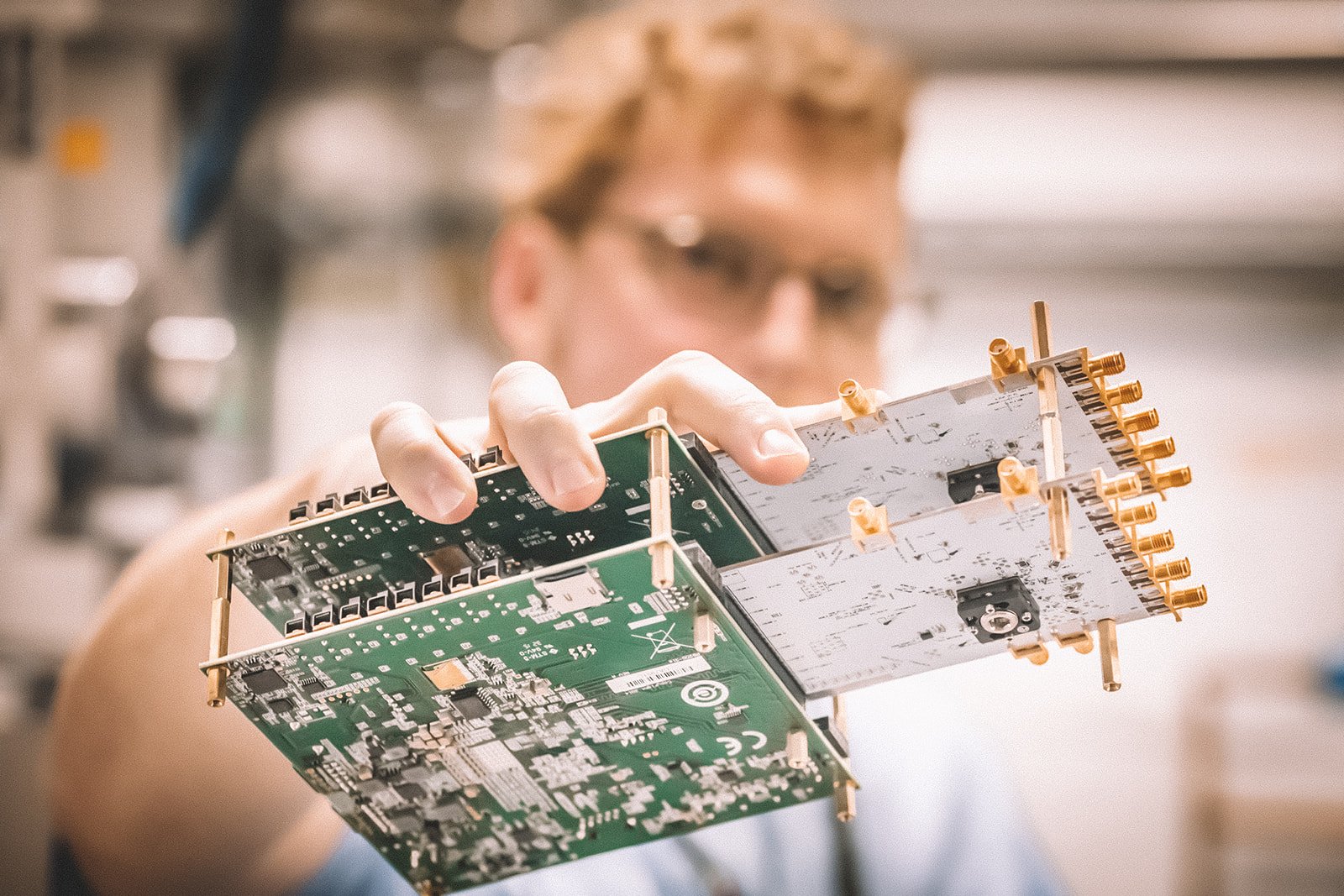Nalu Scientific measures the universe from Hawaii
At the heart of every flourishing innovation community is one or two universities that conduct research, train and inspire young people, generate innovative ideas and promote start-ups that bring products and services to market.
UH, and the Mānoa Campus in particular, play this essential role for Hawaii’s startup tech community, and one of their recent and growing achievements is Nalu Scientific. Founded in 2016 by Isar Mostafanezhad after postdoctoral research at the Physics Department of Mānoa, the company focuses on advanced electronics, including the interface to sensor applications in fast timing measurements.
The company says its cutting-edge technology is used in many areas, including electron collider experiments, remote sensing applications in space, medical imaging technologies, and underwater ranging using a method called lidar.
Ben Rotter, physicist at Nalu Scientific, helps test a lidar microchip from Nalu Scientific. Lidar stands for Light Detection and Ranging, a further development of precise distance measurement. | Photo: Courtesy of Nalu Scientific
Steve Auerbach, interim director of the UH’s Office of Innovation and Commercialization, says Nalu has received more than 23 federal small business innovation research grants and more than $ 10 million in funding over the five years.
“On this trip, Isar worked with a number of UH researchers in research and product development, hired a number of UH students and graduates, mentored innovators and entrepreneurs who want to follow in his footsteps, and spent his time in a variety of ways Provided to support the efforts of the UH and the state to diversify the economy, ”says Auerbach.
“As a UH alumnus, the Isar is an inspiration for students and researchers and a role model for those who want to join forces with the innovation and entrepreneurial community to create more high-tech jobs for our local students and diversify our economy.”
Kenneth Lauritzen started as an intern at Nalu during an engineering student at UH and is now working there as a junior engineer. “Without Nalu Scientific, I would have moved out of Hawaii for a job in my area. There are very few opportunities in Hawaii as interesting as what Nalu Scientific has to offer, ”he says.
Senior engineer Ryan Pang had spent more than 10 years on the mainland working on systems for the aerospace, automotive and consumer electronics industries. “Nalu Scientific allowed me to return to Hawaii and stay in a research and development-focused engineering position instead of moving to a different technical position,” he says.
Mostafanezhad calls UH a “world class university” and says he’s glad that Nalu allowed some of its graduates to live in Hawaii while they work in high-tech jobs. “My family had to come to the United States to have the opportunity to develop and flourish our talents. I understand what a sacrifice it is to leave your home to build a successful life, ”he says.
“I’m grateful that Nalu made it possible for many locals to study and pursue a career in engineering and then find an engineering job right here in Hawaii.”
“Working from home has a new meaning these days, but staying in or returning to Hawaii was a shared and persistent goal for kama’āina. To earn a living here and actually enjoy the quality of life that only Hawaii offers, I hope that every local company can offer them. “

Part of the process to build one of Nalu Scientific’s bespoke microchips. | Photo: Courtesy of Nalu Scientific
According to Auerbach, the UH’s Office for Innovation and Commercialization promotes collaboration between the UH and the community to renew local businesses and create high-quality jobs. “Nalu is a prime example of this and Isar is working with UH OIC to share its knowledge and to replicate and scale its model of success,” says Auerbach.
“I see Nalu Scientific’s work as a force multiplier.”
He says the university’s research and academic company brings in more than $ 400 million in third-party funding annually. “Partnerships and collaboration with the private sector are the basis for a thriving ecosystem for innovation and entrepreneurship.”
He says one way to grow the local innovation community is to inspire more young minds. “In my opinion, we need to do more in terms of engaging and engaging with our K-12 and post-secondary students to help them understand, value, and engage with innovation and entrepreneurship.
“When we have cool deep tech / science / STEM startups like Nalu Scientific for the next generation to see, touch and interact with, great things will come of it.”
The most promising part of Nalu’s work is Mostafanezhad’s team culture, says Auerbach.
“He has embraced a culture of innovation, entrepreneurship and social engagement and put it into practice. He spends a lot of time working with UH and the next generation of founders to help them navigate their research, technology and startup journey. … Isar combines his deep understanding of complex scientific and technical problems with his business acumen to develop solutions that meet market needs, which in turn helps our community diversify the economy. “
Pang, the chief engineer, is optimistic about the future for both Nalu and the wider Hawaiian scientific community. “I think Nalu Scientific has a lot of potential to build Hawaii’s high-tech economy,” he says.
“I think there is a misconception about what it is to be a tech company in Hawaii. Nowadays, coordinating and collaborating with people around the world is as easy as the click of a button. It’s just as easy to develop here in Hawaii as it is in Silicon Valley, ”says Pang.

